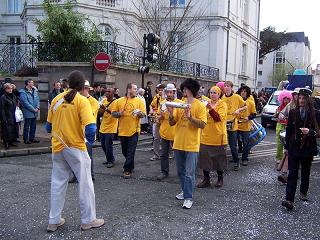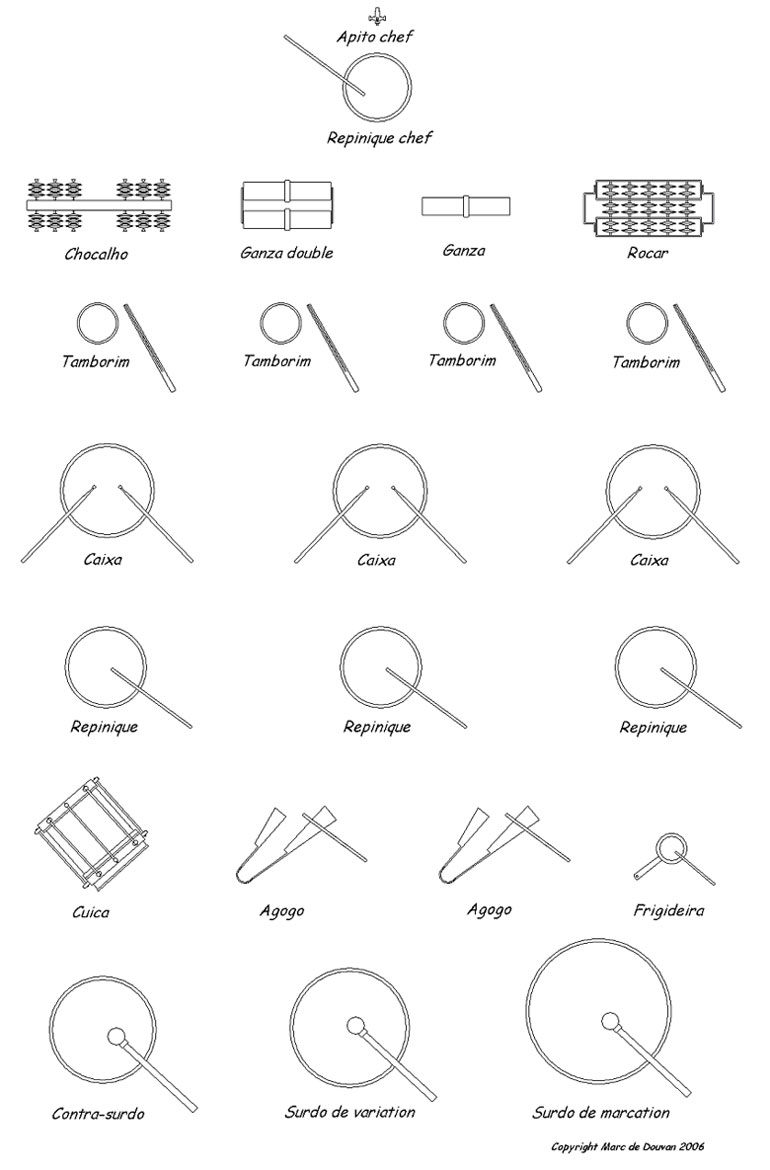
 : : : Lessons : : The walking order of the Brazilian bateria
: : : Lessons : : The walking order of the Brazilian bateria
 The bateria (or "batucada") is the orchestra composed exclusively of percussion instruments which traditionally parades at the Rio de Janeiro Carnival.
The bateria (or "batucada") is the orchestra composed exclusively of percussion instruments which traditionally parades at the Rio de Janeiro Carnival.
Given the variety (often more than a dozen different) and the number of instruments (from a dozen to several hundred (especially in Rio)), it is imperative that the instruments walk in a judicious order. There is no absolute and traditional rule , but for my part, I recommend taking a simple precept of acoustics, used for classical setup of symphony orchestras.
This principle is dictated by a basic physiological noticing that is the more a tone (sound frequency) is low (bass), the more it persists in the distance to our hearing. Therefore, the larger the orchestra is, the greater the shifting is perceptible and requires the arrangement described schematically below, more to facilitate the conducting of the leader, than for the public, which is placed on the sides and see anyway passing each instrument in front of him (but he prefers anyway generally to see the band arriving (the face of the instrumentalists) than going away (their back)).
The extreme listening distance of the conductor can be accentuated by the need of thinness of the line imposed by the road (the public is usually placed on the sidewalks). If the Sambadrome, the avenue of Rio where the Carnival takes place, is very large (a bit like the Champs-Élysées in Paris), this is not the case for all the roads where parade the carnivals more intimate and informal of smaller cities (especially in France where the map of town centers often follows a pattern of winding and chaotic medieval streets).
So, the principle is the following: the conductor should be placed first (forward) to guide the progress of the band (stop, speed, acceleration and deceleration of walking). So the conductor must walk backwards to watch always his musicians.
The other instruments are arranged in categories according to an order going from the highest to the lowest, as they are away from the head.
So the head will be made up of the conductor ("chef" ("chief") in France which means also "head" in French and called "mestre de ("master of") bateria" in Brazil) using an apito (whistle) or repinique (some conductors let this repinique leader role to a member of the repinique section), followed immediately by shakers (super-high shaking instruments: chocalho (with "cymbalettes"), ganza (with grains), etc.), followed by the tamborims, then the caixas (snare drums, which their snare tends to high-pitched tones), then the repiniques (without snare), then , mediums and tuned instruments (with more accurate fundamental tones: agogos, cuica, frigideira), and finally, the surdos (the largest and lowest drums).
The diagram presented below represents a bateria that gathers together all the variety of the parade instruments (with high natural sound power), with a medium number of members (more or less twenty).
You can enlarge the band by adding players to the sides, and if the width of the street of the course does not allow (which is rare because the organizers usually choose the avenues of cities) you can double the number of rows of each type of instrument (with the same order).
It is anyway better that the band is as dense as possible and then the space between each musician minimal, to provide homogeneous music (because each type of instrument performs a different rhythm, traditionally, which increases the disparate appearance).

Finally, note that it is better for players to see the conductor (which allows him to make visual signs, including showing the numbers of the breaks with the fingers), which may involve a staggered arrangement of the musicians.

Marc de Douvan, January 2006, translated in English in June 2013 
© 2005 Marc de Douvan Crédits Mentions légales
